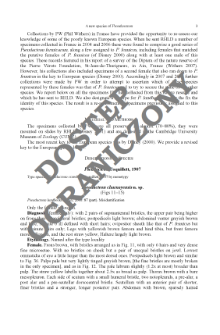- Search in all Repository
- Literature and maps
- Archeology
- Mills database
- Natural sciences
Advanced search
Advanced search
Advanced search
Advanced search
Advanced search

Object
Title: Morphometric plasticity in Prionchulus punctatus (Cobb, 1917) Andrássy, 1958 and Clarkus papillatus (Bastian, 1865) Jairajpuri, 1970 (Nematoda: Mononchida): adaptation to different humus forms?
Subtitle:
Annales Zoologici, vol. 50, no 2 ; Morphometric plasticity in Mononchida
Contributor:
Polska Akademia Nauk. Muzeum i Instytut Zoologii
Publisher:
Muzeum i Instytut Zoologii PAN
Place of publishing:
Description:
Na s. red. błedny ISSN 0001-6454 ; Bibliogr. s. 169-170 ; S. 165-175 : il. ; 24 cm
Type of object:
Abstract:
Morphometric variability was studied in Prionchulus punctatusand Clarkus papillatus from closely related forest sites: Site 1 (eutrophic to calcic mull humus), site 2 (contiguous tosite 1, eutrophic mull humus with amore or less leached soil), site 3 (acid mull humus), site 4 (located in site 3 but just under the crown of an old oak, moder humus), site 7 (moder humus, developedin a wide area). Results from correspondence analysis for both nematode species from site 2 suggested two distinct population types (a) with small individuals (Pp: 1.85 ± 0.05 mm and 87.2±5.7 μm for body length and tail length respectively; Cp: 1.11±0.02 mm and 78.5±1.9 μm)with typical characteristics of populations collected from acalcic mull and (b) larger individuals (Pp: 2.14 ± 0.04 mm and 100.2 ± 1.8 μm for body length and tail length respectively; Cp:1.21±0.01 mm and 83.3±2.2μm) similar to populations collected from an eutrophic mull. Results from correspondence analysis from site 4 showed that the populations of the two species had intermediate characteristics between populations collected from a mull humus and from a moder humus. Moreover, a laboratory culturing experiment with adult Clarkus papillatus collected from site 3 and cultured on three humus forms (calcic mull, site 1; acid mull, site 3; moder, site 7) showed that this species reproduced successfully on mull acid only. The conjunctural or the structural influence on morphometric plasticity of these species is discussed from a functional ecology aspect.
Relation:
Volume:
Issue:
Start page:
End page:
Detailed Resource Type:
Format:
Resource Identifier:
Source:
MiIZ PAN, sygn. patrz sygn. czas. P.255, vol 50, no 2 ; MiIZ PAN, sygn. patrz sygn. czas. P.4314, vol 50, no 2 ; click here to follow the link
Language:
Language of abstract:
Rights:
Prawa zastrzeżone - dostęp ograniczony
Terms of use:
Digitizing institution:
Muzeum i Instytut Zoologii Polskiej Akademii Nauk
Original in:
Biblioteka Muzeum i Instytutu Zoologii PAN
Projects co-financed by:
Program Operacyjny Innowacyjna Gospodarka, lata 2010-2014, Priorytet 2. Infrastruktura strefy B + R ; Unia Europejska. Europejski Fundusz Rozwoju Regionalnego
Access:
Object collections:
- Digital Repository of Scientific Institutes > Partners' collections > Museum and Institute of Zoology PAS > Scientific Journals
- Digital Repository of Scientific Institutes > Partners' collections > Museum and Institute of Zoology PAS > MIZ PAN Publications > Annales Zoologici
- Digital Repository of Scientific Institutes > Literature > Journals/Articles
Last modified:
Feb 4, 2025
In our library since:
Sep 24, 2015
Number of object content downloads / hits:
52
All available object's versions:
https://rcin.org.pl./publication/73791
Show description in RDF format:
Show description in RDFa format:
Show description in OAI-PMH format:
Objects Similar
Winiszewska-Ślipińska, Grażyna Skwiercz, Andrzej T. Państwowe Wydawnictwo Naukowe (1951–1992) Polska Akademia Nauk. Instytut Zoologii
Winiszewska-Ślipińska, Grażyna
Brzeski, Michał W.
Ahmad, Wasim
Winiszewska-Ślipińska, Grażyna Państwowe Wydawnictwo Naukowe (1951–1992) Polska Akademia Nauk. Instytut Zoologii
Roguska-Wasilewska, Lucyna
Wasilewska, Lucyna
Pieczyńska, Ewa

 INSTYTUT ARCHEOLOGII I ETNOLOGII POLSKIEJ AKADEMII NAUK
INSTYTUT ARCHEOLOGII I ETNOLOGII POLSKIEJ AKADEMII NAUK
 INSTYTUT BADAŃ LITERACKICH POLSKIEJ AKADEMII NAUK
INSTYTUT BADAŃ LITERACKICH POLSKIEJ AKADEMII NAUK
 INSTYTUT BADAWCZY LEŚNICTWA
INSTYTUT BADAWCZY LEŚNICTWA
 INSTYTUT BIOLOGII DOŚWIADCZALNEJ IM. MARCELEGO NENCKIEGO POLSKIEJ AKADEMII NAUK
INSTYTUT BIOLOGII DOŚWIADCZALNEJ IM. MARCELEGO NENCKIEGO POLSKIEJ AKADEMII NAUK
 INSTYTUT BIOLOGII SSAKÓW POLSKIEJ AKADEMII NAUK
INSTYTUT BIOLOGII SSAKÓW POLSKIEJ AKADEMII NAUK
 INSTYTUT CHEMII FIZYCZNEJ PAN
INSTYTUT CHEMII FIZYCZNEJ PAN
 INSTYTUT CHEMII ORGANICZNEJ PAN
INSTYTUT CHEMII ORGANICZNEJ PAN
 INSTYTUT FILOZOFII I SOCJOLOGII PAN
INSTYTUT FILOZOFII I SOCJOLOGII PAN
 INSTYTUT GEOGRAFII I PRZESTRZENNEGO ZAGOSPODAROWANIA PAN
INSTYTUT GEOGRAFII I PRZESTRZENNEGO ZAGOSPODAROWANIA PAN
 INSTYTUT HISTORII im. TADEUSZA MANTEUFFLA POLSKIEJ AKADEMII NAUK
INSTYTUT HISTORII im. TADEUSZA MANTEUFFLA POLSKIEJ AKADEMII NAUK
 INSTYTUT JĘZYKA POLSKIEGO POLSKIEJ AKADEMII NAUK
INSTYTUT JĘZYKA POLSKIEGO POLSKIEJ AKADEMII NAUK
 INSTYTUT MATEMATYCZNY PAN
INSTYTUT MATEMATYCZNY PAN
 INSTYTUT MEDYCYNY DOŚWIADCZALNEJ I KLINICZNEJ IM.MIROSŁAWA MOSSAKOWSKIEGO POLSKIEJ AKADEMII NAUK
INSTYTUT MEDYCYNY DOŚWIADCZALNEJ I KLINICZNEJ IM.MIROSŁAWA MOSSAKOWSKIEGO POLSKIEJ AKADEMII NAUK
 INSTYTUT PODSTAWOWYCH PROBLEMÓW TECHNIKI PAN
INSTYTUT PODSTAWOWYCH PROBLEMÓW TECHNIKI PAN
 INSTYTUT SLAWISTYKI PAN
INSTYTUT SLAWISTYKI PAN
 SIEĆ BADAWCZA ŁUKASIEWICZ - INSTYTUT TECHNOLOGII MATERIAŁÓW ELEKTRONICZNYCH
SIEĆ BADAWCZA ŁUKASIEWICZ - INSTYTUT TECHNOLOGII MATERIAŁÓW ELEKTRONICZNYCH
 MUZEUM I INSTYTUT ZOOLOGII POLSKIEJ AKADEMII NAUK
MUZEUM I INSTYTUT ZOOLOGII POLSKIEJ AKADEMII NAUK
 INSTYTUT BADAŃ SYSTEMOWYCH PAN
INSTYTUT BADAŃ SYSTEMOWYCH PAN
 INSTYTUT BOTANIKI IM. WŁADYSŁAWA SZAFERA POLSKIEJ AKADEMII NAUK
INSTYTUT BOTANIKI IM. WŁADYSŁAWA SZAFERA POLSKIEJ AKADEMII NAUK




































